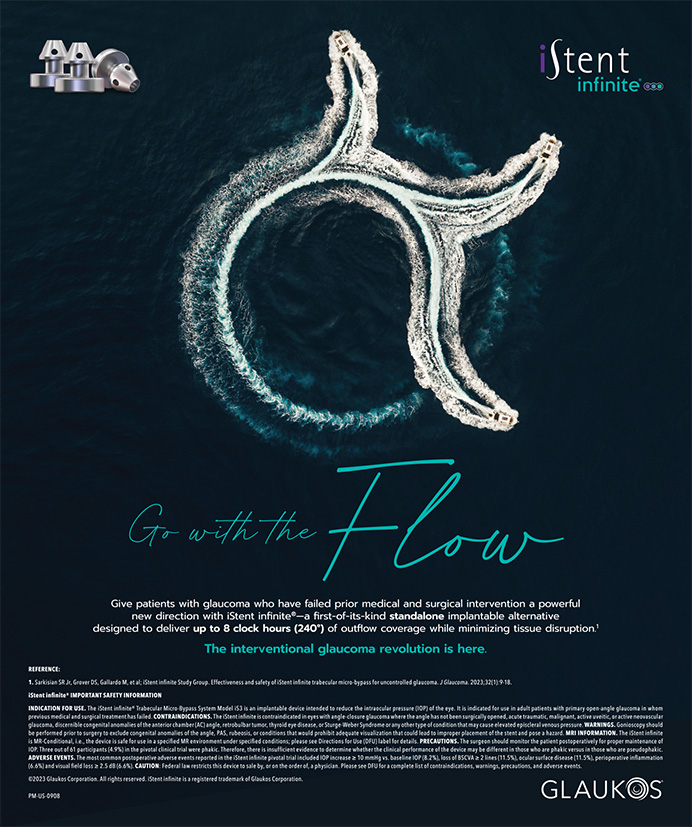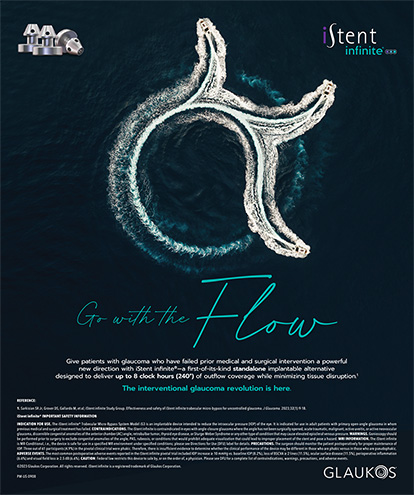

Dennis Akrobetu, MD: Given the many options for refractive surgery available today, what attributes make someone a suitable candidate for LASIK or PRK?
Neda Nikpoor, MD: When evaluating patients for refractive surgery, two critical factors are age and corneal topography. A patient’s refractive error, lifestyle, and specific activities also guide your decision-making.
Age. This is an important consideration, especially if patients are approaching the age for cataract surgery or refractive lens exchange. It is crucial to understand that, although LASIK is popular, it is not the only available option. Your responsibility extends beyond immediate corrections; you should also plan for patients’ visual needs throughout their lifetime.
Corneal topography. Ensure that the topography is regular and there is sufficient corneal thickness for laser correction. A refractive error in excess of -8.00 D raises the risk of inducing higher-order aberrations.1 An eye with more than -6.00 D of myopia is at increased risk of developing haze after PRK.2 In either situation, you may want to consider alternative procedures.
Modern evaluations have broadened their scope beyond mere anterior corneal analysis to incorporate advanced techniques such as OCT-based epithelial mapping for early keratoconus detection. We often see patients with localized inferior steepening on topography also show epithelial thickening in those regions—a sign frequently linked to contact lens overwear. When both topography and OCT are leveraged, these patients typically qualify for LASIK, circumventing exclusion based solely on topographic data.
Lifestyle. High-impact activities such as boxing or martial arts may sway you to consider alternatives to flap-based procedures such as PRK, SMILE, or intraocular methods. If the patient’s lifestyle involves high UV exposure—such as surfing, boating, or outdoor construction work—consider alternatives to standard PRK treatments. PRK can be safely performed with intraoperative use of mitomycin C, supplemented by postoperative vitamin C and UV protection. Should UV protection be impractical for the patient, an EVO ICL (STAAR Surgical) can be a viable option.
Dr. Akrobetu: Given that patients sometimes express a preference for LASIK or PRK, are there elements of their history or details that you view as absolute contraindications?
Dr. Nikpoor: First, it’s important to understand why a patient favors a particular laser vision correction method. Often, their choice stems from familiarity, so proper education is crucial in steering them toward the most suitable procedure. Although our training provides a list of strict contraindications for refractive surgeries, real-world experience often pushes those boundaries. For me, an absolute contraindication is pregnancy. I also exercise caution with patients who have used isotretinoin therapy and have compromised meibomian gland function.
Dr. Akrobetu: What about the more ambiguous, relative contraindications such as glaucoma or autoimmune diseases?
Dr. Nikpoor: Relative contraindications have evolved. For example, glaucoma was once considered a hard stop for LASIK or PRK. With advances in monitoring glaucomatous progression, it has become more about calculating individual risks.3 The same goes for a history of herpes simplex virus keratitis and well-managed autoimmune diseases.4
Although breastfeeding is generally a relative contraindication, the quality-of-life improvement offered by refractive surgery can justify the procedure. The key is clear communication about the procedure’s potential risks, such as the need for the mother to pump and dump her breast milk if medications such as diazepam are involved.
Dr. Akrobetu: It seems that individual judgment has great influence on these decisions. Let’s switch gears and discuss IOP in the context of surgeries that reshape the cornea. How important is this aspect?
Dr. Nikpoor: IOP remains a key metric in glaucoma management, but it’s not a standalone indicator. Advances in technology, including OCT, retinal nerve fiber layer analysis, and IOP-adjustment tables based on tissue removal, have simplified the monitoring of postoperative glaucomatous progression.3 It’s worth noting that an IOP spike lasting around 20 seconds occurs during flap creation. When the glaucoma is mild, the IOP spike is usually inconsequential. In advanced glaucoma cases, however, this risk merits attention. In such cases, you may opt for alternative procedures such as PRK or SMILE.
Dr. Akrobetu: When considering all these clinical aspects, your approach to refractive surgery seems to be an art as much as a science. Many contraindications are not black-and-white decisions and require a nuanced understanding as well as open patient communication.
Dr. Nikpoor: Absolutely. The keys are to balance evidence-based medicine with individual needs and ensure patients are well informed of the risks and benefits of the procedure.
Dr. Akrobetu: On a related topic, could you elaborate on how SMILE compares to LASIK and PRK?
Dr. Nikpoor: Opinions on SMILE vary. A small subset of US surgeons favor SMILE over LASIK or PRK. The story is different in other countries. When the VisuMax 800 (Carl Zeiss Meditec) becomes available in the United States, surgeon preferences here might shift if outcomes improve.
Many US surgeons report that patients’ visual recovery is slower after SMILE.5-7 Some, however, achieve results comparable to LASIK in the early postoperative period.8-11 SMILE also has some limitations in terms of enhancements compared to LASIK and PRK. On the flip side, experts such as Dan Z. Reinstein, MD, MA(Cantab), FRCSC, DABO, FRCOphth, FEBO, and several surgeons in South Korea have reported a lower incidence of postoperative dry eye disease and greater patient comfort with SMILE.11,12
Dr. Akrobetu: Are there any advances that you are excited about?
Dr. Nikpoor: Outside the United States, two innovations are generating a lot of interest. One is Presbyond Laser Blended Vision with the MEL excimer laser platform (Carl Zeiss Meditec), which reshapes the cornea to extend depth of focus. This can be especially beneficial for patients with presbyopia. The second innovation is an additive lenticule procedure. This could be a promising approach to managing keratoconus, hyperopia, and presbyopia. Tissue is added to reshape the cornea. Exciting outcomes have already been reported by surgeons in countries such as Nepal.13,14
Dr. Akrobetu: What are your thoughts on the implantation of an EVO ICL as an alternative to PRK, LASIK, and SMILE?
Dr. Nikpoor: I may be biased because I perform many ICL surgeries, but I think the EVO ICL is an incredible option, particularly for patients who wish to avoid corneal modification. ICL surgery is associated with a lower incidence of postoperative dry eye.15 The procedure can treat a higher degree of myopia and is suitable for patients with irregular or thin corneas. I increasingly find myself recommending the ICL, even to patients with low refractive errors.
Dr. Akrobetu: Are there any caveats or challenges you’ve observed when comparing the ICL to LASIK or other procedures?
Dr. Nikpoor: The ICL is effective, but it is important not to disparage LASIK, which has a solid track record. Comparisons of the two procedures should be done carefully. Patients naturally worry about having a flap and the potential associated complications, but in my experience, LASIK flap dislocations are extremely rare. It is essential to communicate each procedure’s benefits without denigrating other offerings.
Dr. Akrobetu: That is an important point. How do patients respond to the idea of ICLs?
Dr. Nikpoor: I find that patients appreciate the rapid vision recovery and reduced dry eye postoperatively. Many are drawn to the procedure because it doesn’t reshape the cornea but rather involves the insertion of a removable lens. Patients seem to really like the idea of a reversible procedure.
Dr. Akrobetu: What about older patients and those with specific eye conditions?
Dr. Nikpoor: I often recommend ICLs to patients over the age of 45 who have myopia because they are likely to develop cataracts soon. Phakic IOL implantation preserves their future IOL options. I also favor ICLs for patients with irregular corneas or contraindications for corneal procedures.
Dr. Akrobetu: How about for patients with keratoconus?
Dr. Nikpoor: The ICL is an excellent alternative for these patients, especially after they undergo CXL. Although PRK could be an option, the recovery process, refractive predictability, and patient comfort make the ICL a preferable choice.
Dr. Akrobetu: As you mentioned, the ICL procedure is technically reversible. Not only does it preserve the corneal architecture, but it also offers an option for future removal, correct?
Dr. Nikpoor: Absolutely. To patients who come in thinking it’s LASIK or nothing, I emphasize the benefits of the ICL. STAAR Surgical uses the phrase surgically removable, but I like to describe it as upgradable. Given the advances in smart IOLs, there is a potential for future upgrades such as lenses that integrate with smartphones or offer augmented reality.
Dr. Akrobetu: Are there emerging trends in refractive surgery that you’d like to highlight?
Dr. Nikpoor: Much is happening in the presbyopia space. For instance, the presbyopia-correcting ICL in Europe—the EVO Viva (STAAR Surgical)—shows promise. Patients desiring presbyopia correction often opt for refractive lens exchange with multifocal lenses. These can be challenging cases, and IOL explantation is sometimes required. A removable presbyopia-correcting option would be a game changer for our patients.
If STAAR Surgical and RxSight could collaborate on an adjustable ICL, that would be phenomenal. Achieving precise refractive correction is challenging owing to the vertex effect. An adjustable ICL would offer remarkable flexibility.
Presbyopia drops such as Vuity (pilocarpine HCl ophthalmic solution 1.25%, Allergan/AbbVie) are making headway, with newer formulations expected to offer a longer duration of action and fewer side effects.16
Dr. Akrobetu: What advice would you offer to residents interested in cataract and refractive surgery?
Dr. Nikpoor: When I was a resident and even a corneal fellow, I questioned the rationale for operating on patients who seemed to have healthy eyes. It seemed more compelling to treat severe pathologies. As I gained experience, I recognized that these aren’t healthy, normal eyes. Many of these patients are legally blind without corrective lenses, severely affecting their quality of life. One of my mentors, Guy M. Kezirian, MD, MBA, FACS, often likens glasses and contact lenses to crutches for a broken leg. Although these aids help patients function, they don’t solve the underlying medical issue. Fortunately, we have proven, safe methods to significantly improve their condition.
My first piece of advice is to recognize the profound impact refractive surgery can have on patient quality of life (see A Transformative Patient Experience). It’s not solely about financial gains; it’s also about meaningfully improving quality of life and liberating patients from their dependence on visual aids.
A TRANSFORMATIVE PATIENT EXPERIENCE
A Case Presentation From Dr. Nikpoor
Understanding a patient’s motivation for seeking vision correction goes beyond general reasons; it requires truly listening to their individual stories. I vividly recall a patient with a -6.00 D myopic prescription who had recently lost her husband. Before her LASIK procedure, she would wake up in the middle of the night gripped by fear and anxiety and feeling vulnerable. After LASIK, her life changed dramatically: She felt a newfound sense of safety. Now able to navigate her home confidently at night, she could quickly respond to her children in case of a nighttime emergency or disturbance.
That’s the transformative power of refractive surgery.
The second point is about the art and science of the procedure. When learning refractive surgery, it’s tempting to seek hard cutoffs for decision-making, but patient selection often involves a nuanced evaluation of many factors. As more procedural options are developed, refractive surgery increasingly becomes an art. We must weigh multiple factors in the green, yellow, and red zones to determine the most suitable approach to vision correction.
1. McAlinden C, Moore JE. Comparison of higher order aberrations after LASIK and LASEK for myopia. J Refract Surg. 2010;26(1):45-51.
2. Stojanovic A, Nitter TA. Correlation between ultraviolet radiation level and the incidence of late-onset corneal haze after photorefractive keratectomy. J Cataract Refract Surg. 2001;27(3):404-410.
3. Banegas SA, Antón A, Morilla A, et al. Evaluation of the retinal nerve fiber layer thickness, the mean deviation, and the visual field index in progressive glaucoma. J Glaucoma. 2016;25(3):e229-e235.
4. Smith RJ, Maloney RK. Laser in situ keratomileusis in patients with autoimmune diseases. J Cataract Refract Surg. 2006;32(8):1292-1295.
5. Tay E, Bajpai E. Visual recovery after small incision lenticule extraction (SMILE) in relation to pre-operative spherical equivalent. Graefes Arch Clin Exp Ophthalmol. 2021;259(4):1053-1060.
6. Stephenson M. The current state of SMILE vs. LASIK. Review of Ophthalmology. April 15, 2021. Accessed September 12, 2023. https://www.reviewofophthalmology.com/article/the-current-state-of-smile-vs-lasik
7. Rebenitsch RL. SMILE vs. LASIK: Which offers better early visual recovery? AAO. October 16, 2018. Accessed September 12, 2023. https://www.aao.org/education/editors-choice/smile-vs-lasik-which-offers-better-early-visual-re
8. Chong JK, Hamilton DR. SMILE for myopic astigmatism: early experience in the USA and international advances. Curr Ophthalmol Rep. 2020;8:226-235.
9. Liu T, Lu G, Chen K, Kan Q, Bai J. Visual and optical quality outcomes of SMILE and FS-LASIK for myopia in the very early phase after surgery. BMC Ophthalmol. 2019;19(1):88.
10. Du H, Zhang B, Wang Z, Xiong L. Quality of vision after myopic refractive surgeries: SMILE, FS-LASIK, and ICL. BMC Ophthalmol. 2023;23(1):291.
11. Guo H, Hosseini-Moghaddam SM, Hodge W. Corneal biomechanical properties after SMILE versus FLEX, LASIK, LASEK, or PRK: a systematic review and meta-analysis. BMC Ophthalmol. 2019; 19(1):167.
12. Miura M, Inomata T, Nakamura M, et al. Prevalence and characteristics of dry eye disease after cataract surgery: a systematic review and meta-analysis. Ophthalmol Ther. 2022;11(4):1309-1332.
13. Pradhan KR, Reinstein DZ, Vida RS, et al. Femtosecond laser–assisted small incision sutureless intrastromal lamellar keratoplasty (SILK) for corneal transplantation in keratoconus. J Refract Surg. 2019;35(10):663-671.
14. Fasolo A, Galzignato A, Pefrotti E, et al. Femtosecond laser-assisted implantation of corneal stroma lenticule for keratoconus. Int Ophthalmol. 2021;41(5):1949-1957.
15. Parkhurst GD, Psolka M, Kezirian GM. Phakic intraocular lens implantation in United States military warfighters: a retrospective analysis of early clinical outcomes of the Visian ICL. J Refract Surg. 2011;27(7):473-81.
16. Waring GO4, Price FWJ, Wirta D, et al. Safety and efficacy of AGN-190584 in individuals with presbyopia: the GEMINI 1 phase 3 randomized clinical trial. JAMA Ophthalmol. 2022;140(4):363-371.




